Role of Nuclear Medicine in Cancer Therapy
VerifiedAdded on 2022/08/15
|10
|2412
|9
AI Summary
Contribute Materials
Your contribution can guide someone’s learning journey. Share your
documents today.
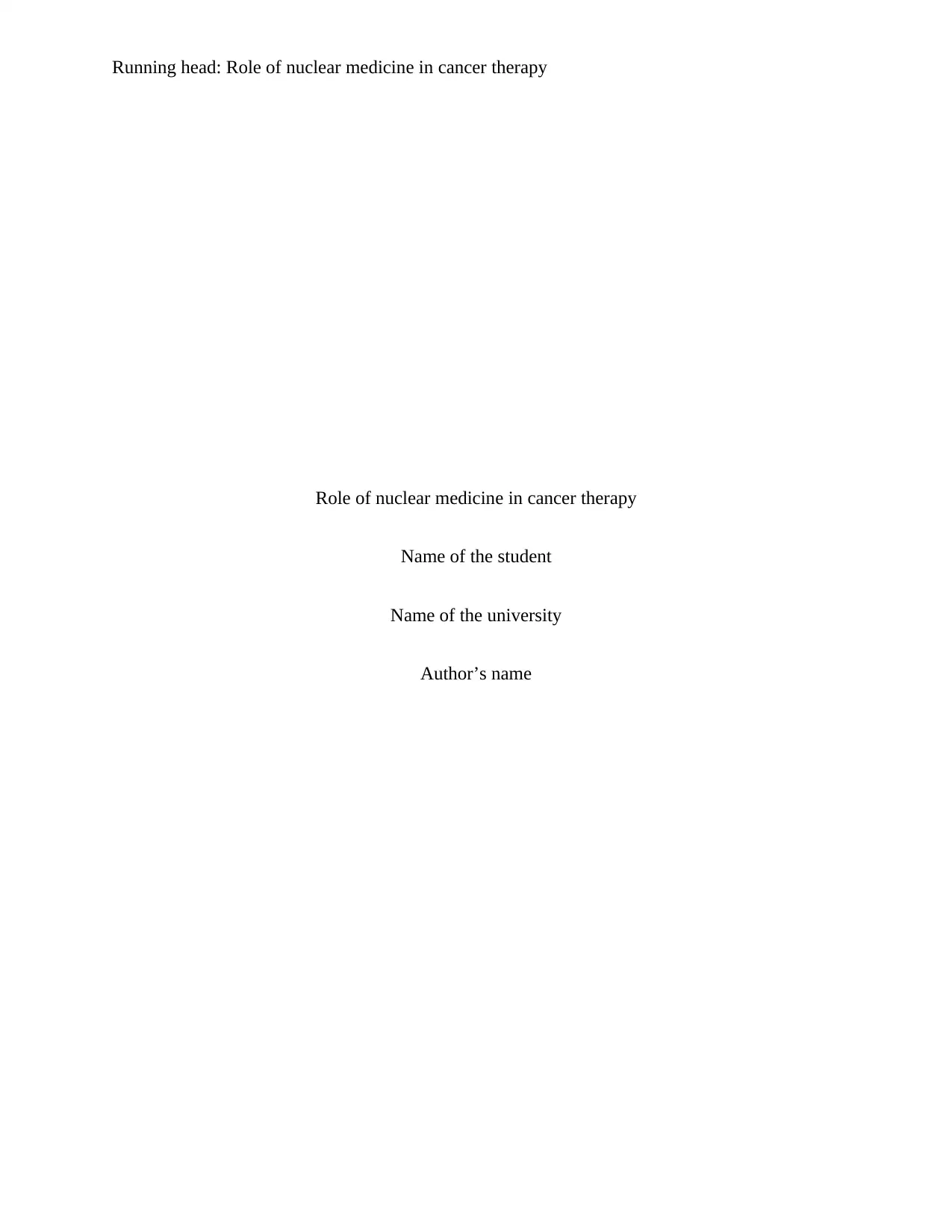
Running head: Role of nuclear medicine in cancer therapy
Role of nuclear medicine in cancer therapy
Name of the student
Name of the university
Author’s name
Role of nuclear medicine in cancer therapy
Name of the student
Name of the university
Author’s name
Secure Best Marks with AI Grader
Need help grading? Try our AI Grader for instant feedback on your assignments.

Role of nuclear medicine in cancer therapy
Introduction
Nuclear medicine is a multidisciplinary area in which instrumentation and tracers
(radiopharmaceuticals) are created and used to research physiological processes and to detect,
initiate, treat diseases without interference. This provides an exceptional way of studying in vivo
cancer biology and to improve cancer treatment for specific patients in particular. A tracer is a
radionuclide alone like iodine-131 or a radiolabel in a carrier molecule or 18F in the
fluorodeoxyglucose (18F-FDG), or another suitable radionuclide bound to a medication, protein
or peptide that accumulates within the tissue of interest when inside the body.
Some studies have performed dual tracer dynamic imaging in this study with staggered
18F Alfatide II and 18F-FDG injections for simultaneous angiogenesis and metabolism
observation, which serve as early sensitive markers of the tumor reaction therapy. With
compartmental modeling, the signal from each tracer was separated successfully. For single
tracer imaging, tumor absorption measurements and complex criteria for retrieved signals have
been confirmed. In order to monitor tumor response to chemotherapy, dual tracer images were
used. They found that dual-tracer single-scan imaging can be used to reflect tumor response and
more sensitive than static imaging is quantitative kinetic parameters calculated from dynamic
data.
Modern cancer therapy has shown its effectiveness in the treatment of patients with many
common cancers and improving their lives. This reduced success is partly due to the relative lack
of specificity in current medical practice for major classes of cancer and cytotoxic technologies.
The approach has been to destroy uncontrolled cell population for the majority of cancer
Introduction
Nuclear medicine is a multidisciplinary area in which instrumentation and tracers
(radiopharmaceuticals) are created and used to research physiological processes and to detect,
initiate, treat diseases without interference. This provides an exceptional way of studying in vivo
cancer biology and to improve cancer treatment for specific patients in particular. A tracer is a
radionuclide alone like iodine-131 or a radiolabel in a carrier molecule or 18F in the
fluorodeoxyglucose (18F-FDG), or another suitable radionuclide bound to a medication, protein
or peptide that accumulates within the tissue of interest when inside the body.
Some studies have performed dual tracer dynamic imaging in this study with staggered
18F Alfatide II and 18F-FDG injections for simultaneous angiogenesis and metabolism
observation, which serve as early sensitive markers of the tumor reaction therapy. With
compartmental modeling, the signal from each tracer was separated successfully. For single
tracer imaging, tumor absorption measurements and complex criteria for retrieved signals have
been confirmed. In order to monitor tumor response to chemotherapy, dual tracer images were
used. They found that dual-tracer single-scan imaging can be used to reflect tumor response and
more sensitive than static imaging is quantitative kinetic parameters calculated from dynamic
data.
Modern cancer therapy has shown its effectiveness in the treatment of patients with many
common cancers and improving their lives. This reduced success is partly due to the relative lack
of specificity in current medical practice for major classes of cancer and cytotoxic technologies.
The approach has been to destroy uncontrolled cell population for the majority of cancer
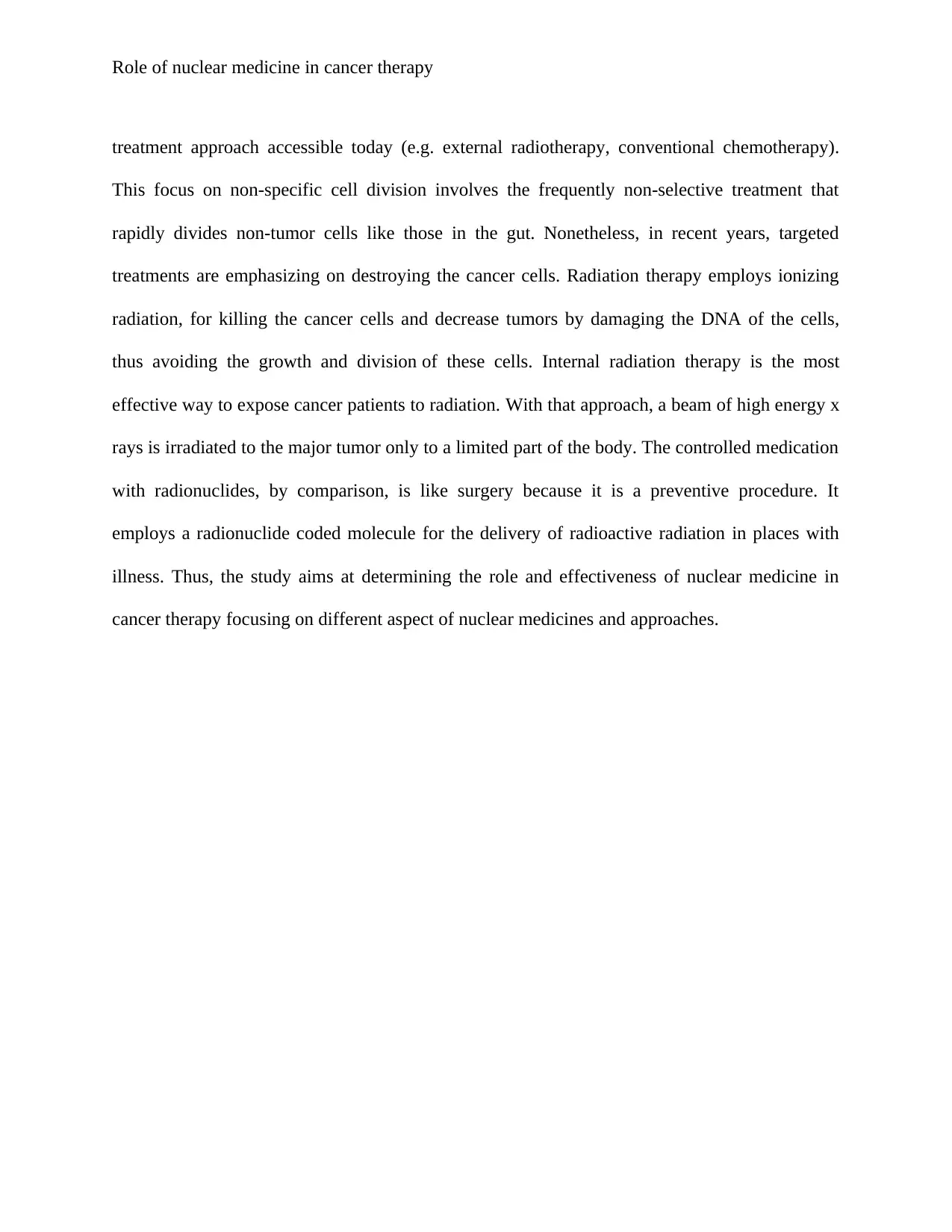
Role of nuclear medicine in cancer therapy
treatment approach accessible today (e.g. external radiotherapy, conventional chemotherapy).
This focus on non-specific cell division involves the frequently non-selective treatment that
rapidly divides non-tumor cells like those in the gut. Nonetheless, in recent years, targeted
treatments are emphasizing on destroying the cancer cells. Radiation therapy employs ionizing
radiation, for killing the cancer cells and decrease tumors by damaging the DNA of the cells,
thus avoiding the growth and division of these cells. Internal radiation therapy is the most
effective way to expose cancer patients to radiation. With that approach, a beam of high energy x
rays is irradiated to the major tumor only to a limited part of the body. The controlled medication
with radionuclides, by comparison, is like surgery because it is a preventive procedure. It
employs a radionuclide coded molecule for the delivery of radioactive radiation in places with
illness. Thus, the study aims at determining the role and effectiveness of nuclear medicine in
cancer therapy focusing on different aspect of nuclear medicines and approaches.
treatment approach accessible today (e.g. external radiotherapy, conventional chemotherapy).
This focus on non-specific cell division involves the frequently non-selective treatment that
rapidly divides non-tumor cells like those in the gut. Nonetheless, in recent years, targeted
treatments are emphasizing on destroying the cancer cells. Radiation therapy employs ionizing
radiation, for killing the cancer cells and decrease tumors by damaging the DNA of the cells,
thus avoiding the growth and division of these cells. Internal radiation therapy is the most
effective way to expose cancer patients to radiation. With that approach, a beam of high energy x
rays is irradiated to the major tumor only to a limited part of the body. The controlled medication
with radionuclides, by comparison, is like surgery because it is a preventive procedure. It
employs a radionuclide coded molecule for the delivery of radioactive radiation in places with
illness. Thus, the study aims at determining the role and effectiveness of nuclear medicine in
cancer therapy focusing on different aspect of nuclear medicines and approaches.
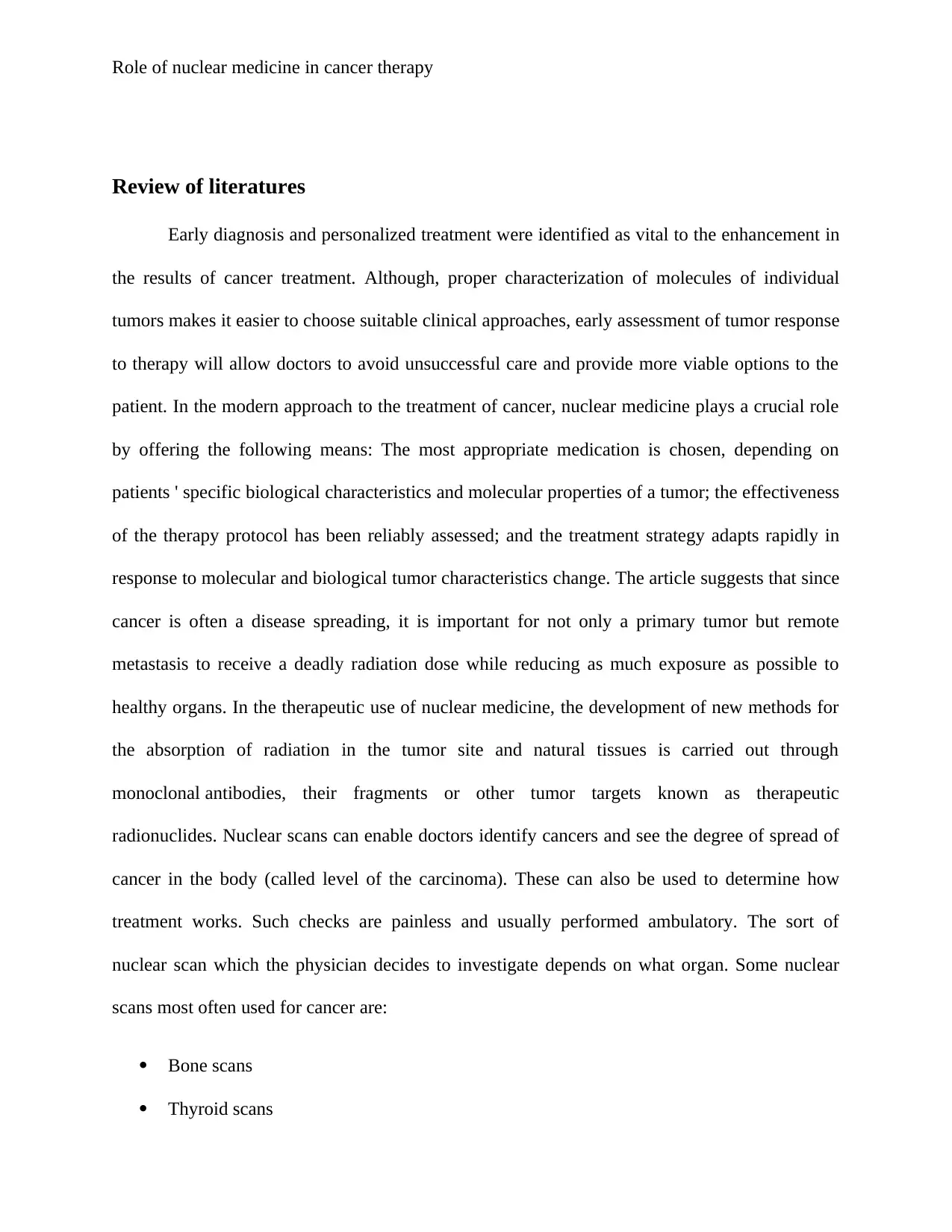
Role of nuclear medicine in cancer therapy
Review of literatures
Early diagnosis and personalized treatment were identified as vital to the enhancement in
the results of cancer treatment. Although, proper characterization of molecules of individual
tumors makes it easier to choose suitable clinical approaches, early assessment of tumor response
to therapy will allow doctors to avoid unsuccessful care and provide more viable options to the
patient. In the modern approach to the treatment of cancer, nuclear medicine plays a crucial role
by offering the following means: The most appropriate medication is chosen, depending on
patients ' specific biological characteristics and molecular properties of a tumor; the effectiveness
of the therapy protocol has been reliably assessed; and the treatment strategy adapts rapidly in
response to molecular and biological tumor characteristics change. The article suggests that since
cancer is often a disease spreading, it is important for not only a primary tumor but remote
metastasis to receive a deadly radiation dose while reducing as much exposure as possible to
healthy organs. In the therapeutic use of nuclear medicine, the development of new methods for
the absorption of radiation in the tumor site and natural tissues is carried out through
monoclonal antibodies, their fragments or other tumor targets known as therapeutic
radionuclides. Nuclear scans can enable doctors identify cancers and see the degree of spread of
cancer in the body (called level of the carcinoma). These can also be used to determine how
treatment works. Such checks are painless and usually performed ambulatory. The sort of
nuclear scan which the physician decides to investigate depends on what organ. Some nuclear
scans most often used for cancer are:
Bone scans
Thyroid scans
Review of literatures
Early diagnosis and personalized treatment were identified as vital to the enhancement in
the results of cancer treatment. Although, proper characterization of molecules of individual
tumors makes it easier to choose suitable clinical approaches, early assessment of tumor response
to therapy will allow doctors to avoid unsuccessful care and provide more viable options to the
patient. In the modern approach to the treatment of cancer, nuclear medicine plays a crucial role
by offering the following means: The most appropriate medication is chosen, depending on
patients ' specific biological characteristics and molecular properties of a tumor; the effectiveness
of the therapy protocol has been reliably assessed; and the treatment strategy adapts rapidly in
response to molecular and biological tumor characteristics change. The article suggests that since
cancer is often a disease spreading, it is important for not only a primary tumor but remote
metastasis to receive a deadly radiation dose while reducing as much exposure as possible to
healthy organs. In the therapeutic use of nuclear medicine, the development of new methods for
the absorption of radiation in the tumor site and natural tissues is carried out through
monoclonal antibodies, their fragments or other tumor targets known as therapeutic
radionuclides. Nuclear scans can enable doctors identify cancers and see the degree of spread of
cancer in the body (called level of the carcinoma). These can also be used to determine how
treatment works. Such checks are painless and usually performed ambulatory. The sort of
nuclear scan which the physician decides to investigate depends on what organ. Some nuclear
scans most often used for cancer are:
Bone scans
Thyroid scans
Secure Best Marks with AI Grader
Need help grading? Try our AI Grader for instant feedback on your assignments.
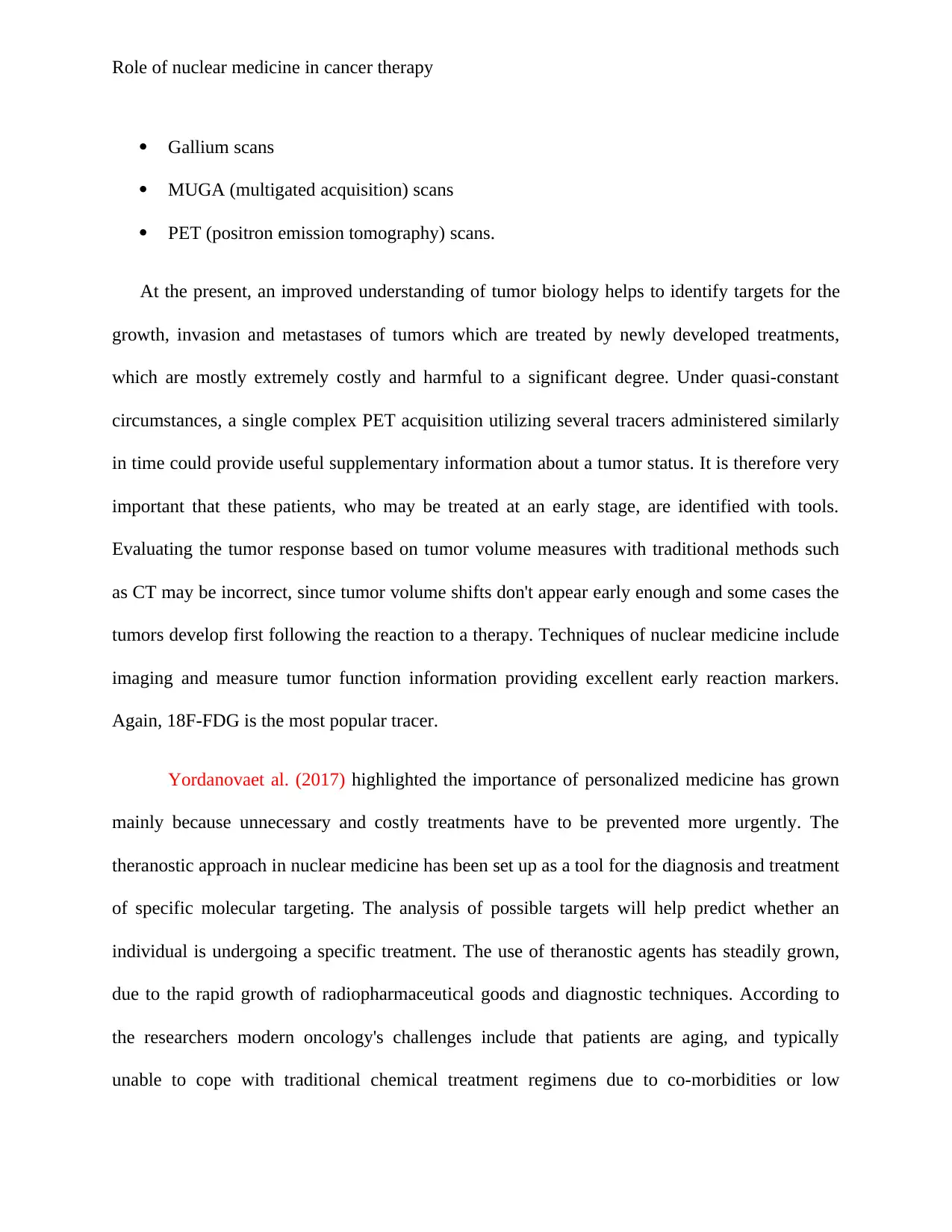
Role of nuclear medicine in cancer therapy
Gallium scans
MUGA (multigated acquisition) scans
PET (positron emission tomography) scans.
At the present, an improved understanding of tumor biology helps to identify targets for the
growth, invasion and metastases of tumors which are treated by newly developed treatments,
which are mostly extremely costly and harmful to a significant degree. Under quasi-constant
circumstances, a single complex PET acquisition utilizing several tracers administered similarly
in time could provide useful supplementary information about a tumor status. It is therefore very
important that these patients, who may be treated at an early stage, are identified with tools.
Evaluating the tumor response based on tumor volume measures with traditional methods such
as CT may be incorrect, since tumor volume shifts don't appear early enough and some cases the
tumors develop first following the reaction to a therapy. Techniques of nuclear medicine include
imaging and measure tumor function information providing excellent early reaction markers.
Again, 18F-FDG is the most popular tracer.
Yordanovaet al. (2017) highlighted the importance of personalized medicine has grown
mainly because unnecessary and costly treatments have to be prevented more urgently. The
theranostic approach in nuclear medicine has been set up as a tool for the diagnosis and treatment
of specific molecular targeting. The analysis of possible targets will help predict whether an
individual is undergoing a specific treatment. The use of theranostic agents has steadily grown,
due to the rapid growth of radiopharmaceutical goods and diagnostic techniques. According to
the researchers modern oncology's challenges include that patients are aging, and typically
unable to cope with traditional chemical treatment regimens due to co-morbidities or low
Gallium scans
MUGA (multigated acquisition) scans
PET (positron emission tomography) scans.
At the present, an improved understanding of tumor biology helps to identify targets for the
growth, invasion and metastases of tumors which are treated by newly developed treatments,
which are mostly extremely costly and harmful to a significant degree. Under quasi-constant
circumstances, a single complex PET acquisition utilizing several tracers administered similarly
in time could provide useful supplementary information about a tumor status. It is therefore very
important that these patients, who may be treated at an early stage, are identified with tools.
Evaluating the tumor response based on tumor volume measures with traditional methods such
as CT may be incorrect, since tumor volume shifts don't appear early enough and some cases the
tumors develop first following the reaction to a therapy. Techniques of nuclear medicine include
imaging and measure tumor function information providing excellent early reaction markers.
Again, 18F-FDG is the most popular tracer.
Yordanovaet al. (2017) highlighted the importance of personalized medicine has grown
mainly because unnecessary and costly treatments have to be prevented more urgently. The
theranostic approach in nuclear medicine has been set up as a tool for the diagnosis and treatment
of specific molecular targeting. The analysis of possible targets will help predict whether an
individual is undergoing a specific treatment. The use of theranostic agents has steadily grown,
due to the rapid growth of radiopharmaceutical goods and diagnostic techniques. According to
the researchers modern oncology's challenges include that patients are aging, and typically
unable to cope with traditional chemical treatment regimens due to co-morbidities or low

Role of nuclear medicine in cancer therapy
efficacy. Additionally, occurrences of side effects may exacerbate treatment compliance in both
young and older patients. Bringing these factors into account is a significant achievement in
personalized medicine, combined with guided cancer screening and therapy. However, on the
contrary, other research suggests that the success of cancer therapy can be difficult to predict,
because its effectiveness is often based on characteristics that are not fully understood or difficult
to identify in the treatment, and in individuals. Therefore, controlling the reaction of the disease
to medication is important and is defined historically by adjustments in the volume of the tumor.
Such particular factor is however also not enough to assess therapeutic effects on patient safety.
Throughout nuclear medicine, the theranostic method incorporates diagnostic imaging
and therapy with the same or at least somewhat close molecules that areradiologically labelled
individually, or are offered throughout different dosages. The gamma and beta-emitters are, say,
iodine-131 and lutetium-177, which enables both the imaging and the treatment of these agents.
In nuclear medicine, theranostics syndicate therapy and diagnostic imaging with the same
molecular or the same agent, but otherwise labeled, in different dosages.Visualizing potential
objectives can help to predict whether a patient would benefit from a specific treatment. Targeted
nuclear therapies with a desirable safety profile have shown effectiveness incorrectly pre-
selected patients. Eventually, guided cancer imaging is an important influence to personalized
medicine and can become an ever more essential part of future cancer screening and therapy
(Yordanova et al., 2017).
The development of molecular imagery has just begun and could bring enormous patient
benefit through earlier detection of tumor, monitoring of treatment response, and a truly personal
treatment approach to cancer. Especially as targeted therapies become the standard components
efficacy. Additionally, occurrences of side effects may exacerbate treatment compliance in both
young and older patients. Bringing these factors into account is a significant achievement in
personalized medicine, combined with guided cancer screening and therapy. However, on the
contrary, other research suggests that the success of cancer therapy can be difficult to predict,
because its effectiveness is often based on characteristics that are not fully understood or difficult
to identify in the treatment, and in individuals. Therefore, controlling the reaction of the disease
to medication is important and is defined historically by adjustments in the volume of the tumor.
Such particular factor is however also not enough to assess therapeutic effects on patient safety.
Throughout nuclear medicine, the theranostic method incorporates diagnostic imaging
and therapy with the same or at least somewhat close molecules that areradiologically labelled
individually, or are offered throughout different dosages. The gamma and beta-emitters are, say,
iodine-131 and lutetium-177, which enables both the imaging and the treatment of these agents.
In nuclear medicine, theranostics syndicate therapy and diagnostic imaging with the same
molecular or the same agent, but otherwise labeled, in different dosages.Visualizing potential
objectives can help to predict whether a patient would benefit from a specific treatment. Targeted
nuclear therapies with a desirable safety profile have shown effectiveness incorrectly pre-
selected patients. Eventually, guided cancer imaging is an important influence to personalized
medicine and can become an ever more essential part of future cancer screening and therapy
(Yordanova et al., 2017).
The development of molecular imagery has just begun and could bring enormous patient
benefit through earlier detection of tumor, monitoring of treatment response, and a truly personal
treatment approach to cancer. Especially as targeted therapies become the standard components

Role of nuclear medicine in cancer therapy
of several cancer regimens, it has become of great interest to be able to clinically monitor the
impact of these molecules through non-invasive imaging techniques. Many methods have been
established to diagnose the cell-level effects of cancer treatment by molecular imaging and are
promising as effective tools for modification and control of care. Good collaboration between
oncology and nuclear medicine is necessary to ensure safe and effective use when using
radionuclide therapies. The bone marrow reserve must be taken into account. Dose modifications
for the elderly may be needed, as most radiopharmaceutical items are approved. Nevertheless,
there is less worry about adverse long-term radiation effects such as second cancers due to
radiation, if any in relation to younger patients. Current precautions can be applied to issues
concerning the safety of medical personnel, healthcare providers and the wider environment.
The study by Barbet et al. (2017) supports the fact that nuclear medicine is considered as
a key factor in developing new treatments and efficient cancer treatment methods are provided
for targeted radionuclide treatment. Many radionuclides, new or better multimodality imaging
equipment, and many recent marketed radiopharmaceuticals in all medical fields, particularly in
neurology, cardiology and oncology, are incredibly innovative (Barbet et al., 2017). Nuclear
Medicine comprises of two primary isotopes, stable, not in time toxic decay and unstable, for
therapeutical purposes. Stable isotopes are primarily used to map biochemical pathways of
humans in pharmacokinetic studies. Throughout current health science, stable isotopes play an
already significant role in the future, as the personalized production of new carbon-13, nitrogen-
15 and oxygen-18 marker compounds and noble gas isotopes are rapidly growing.
Hofman and Hicks (2016) highlights the fact that in comparison with modern, anatomical
methods such as magnetic resonance imaging, computed tomography, nuclear-medicine imagery,
of several cancer regimens, it has become of great interest to be able to clinically monitor the
impact of these molecules through non-invasive imaging techniques. Many methods have been
established to diagnose the cell-level effects of cancer treatment by molecular imaging and are
promising as effective tools for modification and control of care. Good collaboration between
oncology and nuclear medicine is necessary to ensure safe and effective use when using
radionuclide therapies. The bone marrow reserve must be taken into account. Dose modifications
for the elderly may be needed, as most radiopharmaceutical items are approved. Nevertheless,
there is less worry about adverse long-term radiation effects such as second cancers due to
radiation, if any in relation to younger patients. Current precautions can be applied to issues
concerning the safety of medical personnel, healthcare providers and the wider environment.
The study by Barbet et al. (2017) supports the fact that nuclear medicine is considered as
a key factor in developing new treatments and efficient cancer treatment methods are provided
for targeted radionuclide treatment. Many radionuclides, new or better multimodality imaging
equipment, and many recent marketed radiopharmaceuticals in all medical fields, particularly in
neurology, cardiology and oncology, are incredibly innovative (Barbet et al., 2017). Nuclear
Medicine comprises of two primary isotopes, stable, not in time toxic decay and unstable, for
therapeutical purposes. Stable isotopes are primarily used to map biochemical pathways of
humans in pharmacokinetic studies. Throughout current health science, stable isotopes play an
already significant role in the future, as the personalized production of new carbon-13, nitrogen-
15 and oxygen-18 marker compounds and noble gas isotopes are rapidly growing.
Hofman and Hicks (2016) highlights the fact that in comparison with modern, anatomical
methods such as magnetic resonance imaging, computed tomography, nuclear-medicine imagery,
Paraphrase This Document
Need a fresh take? Get an instant paraphrase of this document with our AI Paraphraser
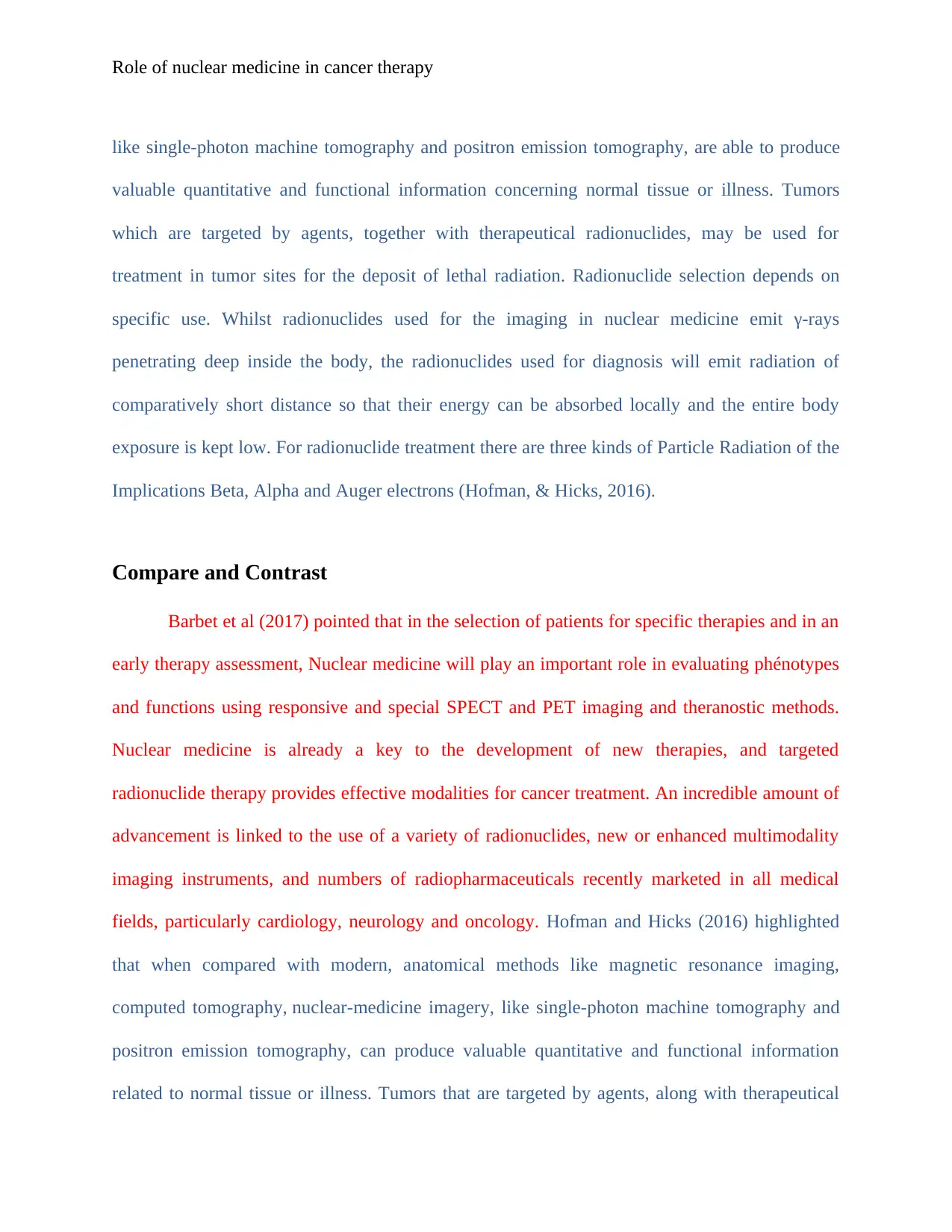
Role of nuclear medicine in cancer therapy
like single-photon machine tomography and positron emission tomography, are able to produce
valuable quantitative and functional information concerning normal tissue or illness. Tumors
which are targeted by agents, together with therapeutical radionuclides, may be used for
treatment in tumor sites for the deposit of lethal radiation. Radionuclide selection depends on
specific use. Whilst radionuclides used for the imaging in nuclear medicine emit γ-rays
penetrating deep inside the body, the radionuclides used for diagnosis will emit radiation of
comparatively short distance so that their energy can be absorbed locally and the entire body
exposure is kept low. For radionuclide treatment there are three kinds of Particle Radiation of the
Implications Beta, Alpha and Auger electrons (Hofman, & Hicks, 2016).
Compare and Contrast
Barbet et al (2017) pointed that in the selection of patients for specific therapies and in an
early therapy assessment, Nuclear medicine will play an important role in evaluating phénotypes
and functions using responsive and special SPECT and PET imaging and theranostic methods.
Nuclear medicine is already a key to the development of new therapies, and targeted
radionuclide therapy provides effective modalities for cancer treatment. An incredible amount of
advancement is linked to the use of a variety of radionuclides, new or enhanced multimodality
imaging instruments, and numbers of radiopharmaceuticals recently marketed in all medical
fields, particularly cardiology, neurology and oncology. Hofman and Hicks (2016) highlighted
that when compared with modern, anatomical methods like magnetic resonance imaging,
computed tomography, nuclear-medicine imagery, like single-photon machine tomography and
positron emission tomography, can produce valuable quantitative and functional information
related to normal tissue or illness. Tumors that are targeted by agents, along with therapeutical
like single-photon machine tomography and positron emission tomography, are able to produce
valuable quantitative and functional information concerning normal tissue or illness. Tumors
which are targeted by agents, together with therapeutical radionuclides, may be used for
treatment in tumor sites for the deposit of lethal radiation. Radionuclide selection depends on
specific use. Whilst radionuclides used for the imaging in nuclear medicine emit γ-rays
penetrating deep inside the body, the radionuclides used for diagnosis will emit radiation of
comparatively short distance so that their energy can be absorbed locally and the entire body
exposure is kept low. For radionuclide treatment there are three kinds of Particle Radiation of the
Implications Beta, Alpha and Auger electrons (Hofman, & Hicks, 2016).
Compare and Contrast
Barbet et al (2017) pointed that in the selection of patients for specific therapies and in an
early therapy assessment, Nuclear medicine will play an important role in evaluating phénotypes
and functions using responsive and special SPECT and PET imaging and theranostic methods.
Nuclear medicine is already a key to the development of new therapies, and targeted
radionuclide therapy provides effective modalities for cancer treatment. An incredible amount of
advancement is linked to the use of a variety of radionuclides, new or enhanced multimodality
imaging instruments, and numbers of radiopharmaceuticals recently marketed in all medical
fields, particularly cardiology, neurology and oncology. Hofman and Hicks (2016) highlighted
that when compared with modern, anatomical methods like magnetic resonance imaging,
computed tomography, nuclear-medicine imagery, like single-photon machine tomography and
positron emission tomography, can produce valuable quantitative and functional information
related to normal tissue or illness. Tumors that are targeted by agents, along with therapeutical
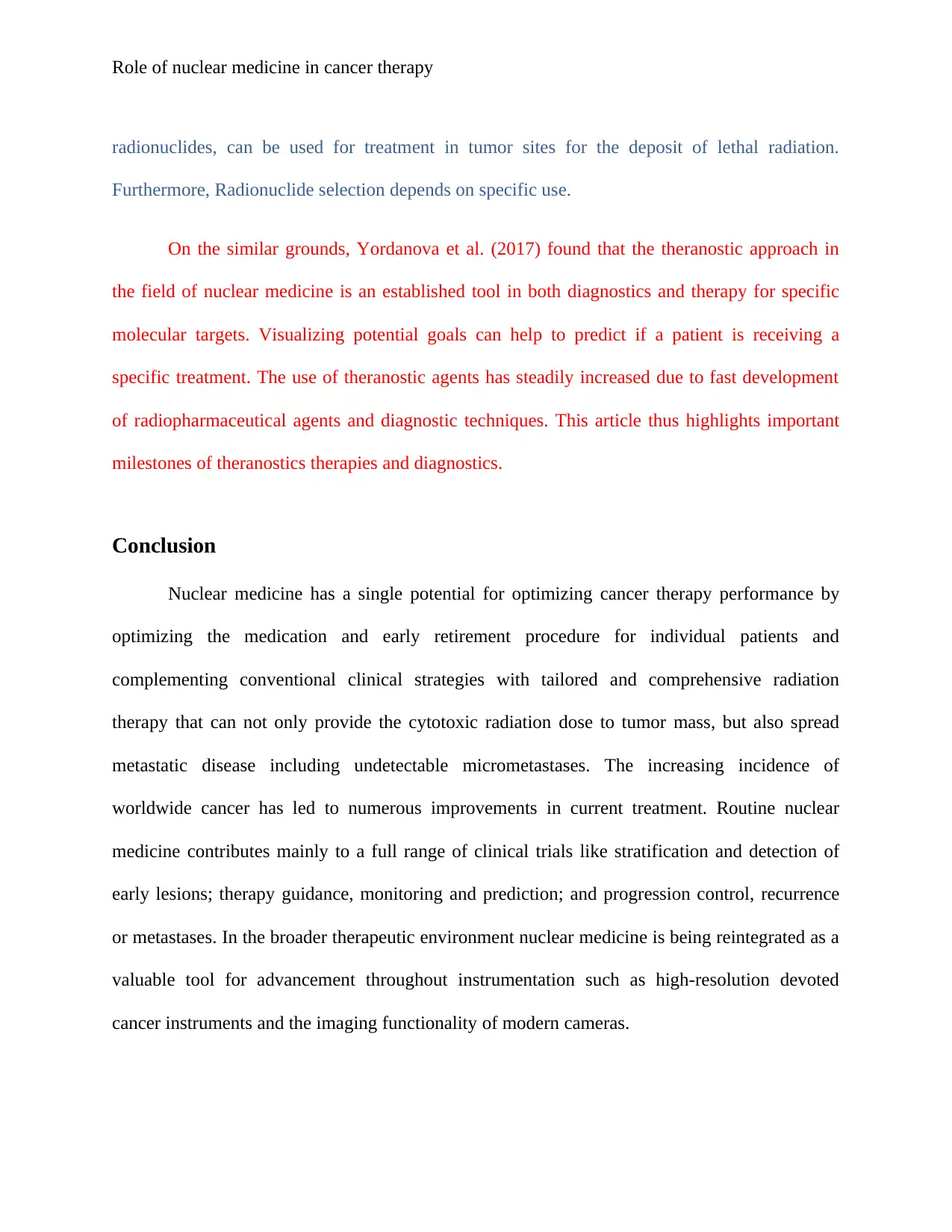
Role of nuclear medicine in cancer therapy
radionuclides, can be used for treatment in tumor sites for the deposit of lethal radiation.
Furthermore, Radionuclide selection depends on specific use.
On the similar grounds, Yordanova et al. (2017) found that the theranostic approach in
the field of nuclear medicine is an established tool in both diagnostics and therapy for specific
molecular targets. Visualizing potential goals can help to predict if a patient is receiving a
specific treatment. The use of theranostic agents has steadily increased due to fast development
of radiopharmaceutical agents and diagnostic techniques. This article thus highlights important
milestones of theranostics therapies and diagnostics.
Conclusion
Nuclear medicine has a single potential for optimizing cancer therapy performance by
optimizing the medication and early retirement procedure for individual patients and
complementing conventional clinical strategies with tailored and comprehensive radiation
therapy that can not only provide the cytotoxic radiation dose to tumor mass, but also spread
metastatic disease including undetectable micrometastases. The increasing incidence of
worldwide cancer has led to numerous improvements in current treatment. Routine nuclear
medicine contributes mainly to a full range of clinical trials like stratification and detection of
early lesions; therapy guidance, monitoring and prediction; and progression control, recurrence
or metastases. In the broader therapeutic environment nuclear medicine is being reintegrated as a
valuable tool for advancement throughout instrumentation such as high-resolution devoted
cancer instruments and the imaging functionality of modern cameras.
radionuclides, can be used for treatment in tumor sites for the deposit of lethal radiation.
Furthermore, Radionuclide selection depends on specific use.
On the similar grounds, Yordanova et al. (2017) found that the theranostic approach in
the field of nuclear medicine is an established tool in both diagnostics and therapy for specific
molecular targets. Visualizing potential goals can help to predict if a patient is receiving a
specific treatment. The use of theranostic agents has steadily increased due to fast development
of radiopharmaceutical agents and diagnostic techniques. This article thus highlights important
milestones of theranostics therapies and diagnostics.
Conclusion
Nuclear medicine has a single potential for optimizing cancer therapy performance by
optimizing the medication and early retirement procedure for individual patients and
complementing conventional clinical strategies with tailored and comprehensive radiation
therapy that can not only provide the cytotoxic radiation dose to tumor mass, but also spread
metastatic disease including undetectable micrometastases. The increasing incidence of
worldwide cancer has led to numerous improvements in current treatment. Routine nuclear
medicine contributes mainly to a full range of clinical trials like stratification and detection of
early lesions; therapy guidance, monitoring and prediction; and progression control, recurrence
or metastases. In the broader therapeutic environment nuclear medicine is being reintegrated as a
valuable tool for advancement throughout instrumentation such as high-resolution devoted
cancer instruments and the imaging functionality of modern cameras.
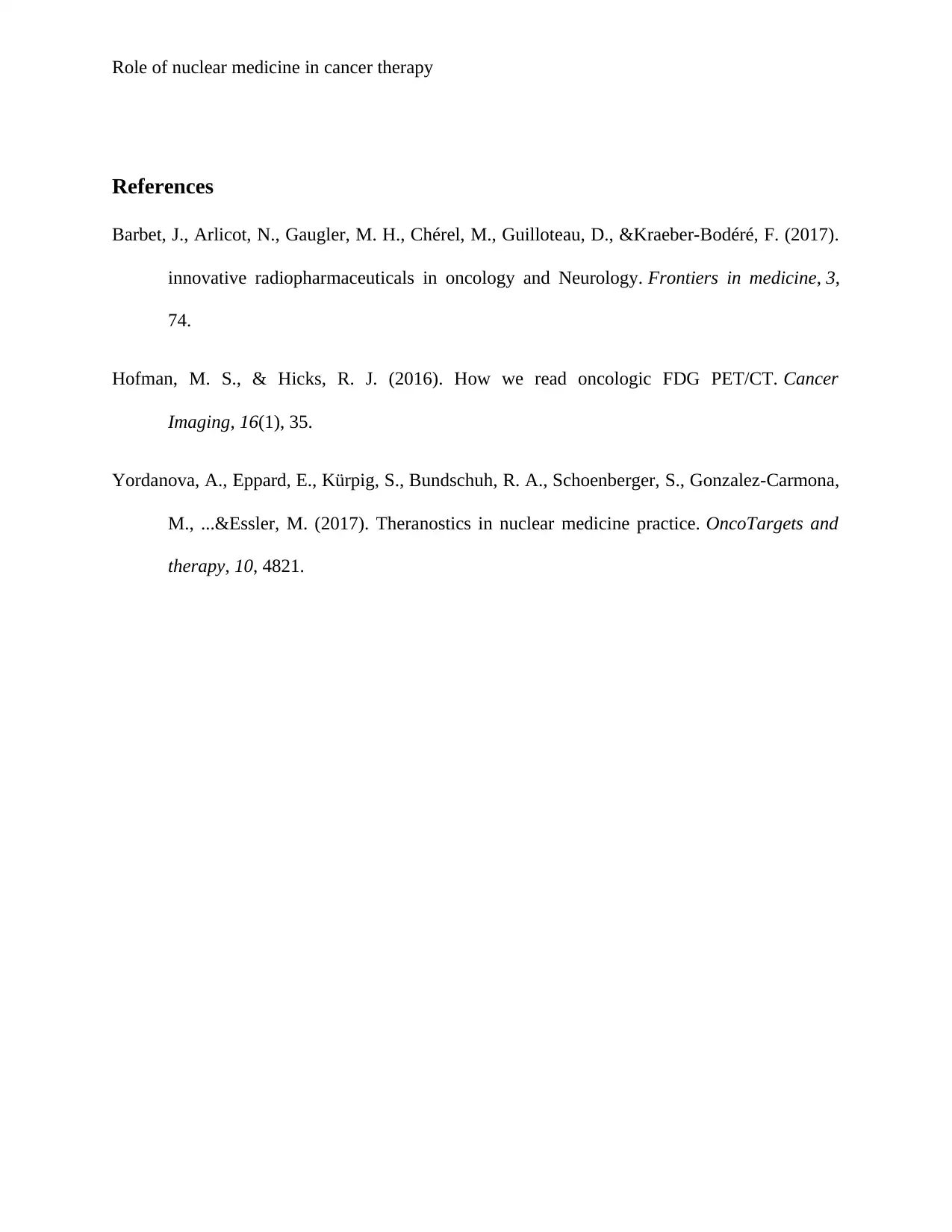
Role of nuclear medicine in cancer therapy
References
Barbet, J., Arlicot, N., Gaugler, M. H., Chérel, M., Guilloteau, D., &Kraeber-Bodéré, F. (2017).
innovative radiopharmaceuticals in oncology and Neurology. Frontiers in medicine, 3,
74.
Hofman, M. S., & Hicks, R. J. (2016). How we read oncologic FDG PET/CT. Cancer
Imaging, 16(1), 35.
Yordanova, A., Eppard, E., Kürpig, S., Bundschuh, R. A., Schoenberger, S., Gonzalez-Carmona,
M., ...&Essler, M. (2017). Theranostics in nuclear medicine practice. OncoTargets and
therapy, 10, 4821.
References
Barbet, J., Arlicot, N., Gaugler, M. H., Chérel, M., Guilloteau, D., &Kraeber-Bodéré, F. (2017).
innovative radiopharmaceuticals in oncology and Neurology. Frontiers in medicine, 3,
74.
Hofman, M. S., & Hicks, R. J. (2016). How we read oncologic FDG PET/CT. Cancer
Imaging, 16(1), 35.
Yordanova, A., Eppard, E., Kürpig, S., Bundschuh, R. A., Schoenberger, S., Gonzalez-Carmona,
M., ...&Essler, M. (2017). Theranostics in nuclear medicine practice. OncoTargets and
therapy, 10, 4821.
1 out of 10
Your All-in-One AI-Powered Toolkit for Academic Success.
+13062052269
info@desklib.com
Available 24*7 on WhatsApp / Email
![[object Object]](/_next/static/media/star-bottom.7253800d.svg)
Unlock your academic potential
© 2024 | Zucol Services PVT LTD | All rights reserved.


